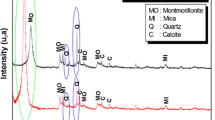Summary
The penetration of the phenanthroline ligand into the interlayer space of the Cu-bentonite results in the formation of Cu(Phen)3-bentonite composite. The expansion of the d001 basal spacing of the Cu-Bent from 14.24 to 17.7 Å on intercalation and the colour change indicate the cation immobilized dimeric ligand species’ presence, which are thermally stable up to 315°C. The shift to higher frequency of the ring vibrations resulted from the π interactions is associated with the linkage of the tilted monomers to the smectite layers at elevated temperatures. The OH stretches and the bending peaks decrease in the intensity in parallel with an easy exchange between the water groups and the aromatic backboned ligands at room temperature.
Similar content being viewed by others
Author information
Authors and Affiliations
Rights and permissions
About this article
Cite this article
Tabak, A., Afsin, B., Aygun, S. et al. Phenanthroline Cu(II)-bentonite composite characterization. J Therm Anal Calorim 81, 311–314 (2005). https://doi.org/10.1007/s10973-005-0784-5
Published:
Issue Date:
DOI: https://doi.org/10.1007/s10973-005-0784-5




